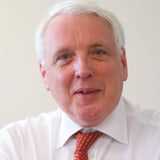contents
For better or for worse, the West will have to wait and see until the post-Putin era, says former top NATO official Jamie Shea.
During the Yugoslav war in the 1990s, Jamie Shea was the face and voice of NATO. The chief spokesman’s press conferences were in the news bulletins almost daily. Later he was deputy general secretary, head of planning and responsible for new risks.
His word carries weight to this day. For him it is clear: It may be selfish for NATO to hold back in Ukraine and focus on defending its 30 member states – but it is realistic. However, the military alliance has by no means done its homework. With the few thousand NATO soldiers on the ground, it would be impossible to defend the Baltic States and other Eastern European countries.
Military strength in favor of Putin
Russia has tens of thousands of soldiers in Belarus alone. The Russian exclave of Kaliningrad is well armed. And large Russian troops are also likely to remain in Ukraine for a long time. The military power balance in Eastern Europe is clearly in Moscow’s favour. NATO is only now considering stationing larger units, but that has not yet been fully discussed.
The fear is now causing a closer alliance in the western camp. Russia’s former dictator Stalin should actually be considered the “father of NATO”, Putin can now be described as the savior of a NATO threatened with collapse. The return to Cold War positioning is obvious and regrettable.
Unfortunately, the Cold War attitude is strengthening again.
NATO is not a threat
From a Western perspective, Russia is not in the least threatened by NATO, says Shea. Many Russian generals, who have now been forced by the Kremlin to go to war against Ukraine, agree. But not Putin and those closest to him.
That is why NATO would do well to distinguish between direct entry into the war and mere aid for Ukraine. The no-fly zone demanded by Kyiv over Ukraine would be such an entry into the war. Merely supplying weapons, including aircraft, is still below the war threshold.
It is worrying that Putin’s armed forces are taking the war very close to the Polish border. A Russian missile could hit NATO territory – at best by mistake.
The hotline between the NATO commander-in-chief and the Russian chief of staff, which is still working for the time being, is therefore indispensable. In this way, at least an unwanted escalation can be avoided.
nuclear weapons?
Shea doesn’t expect Putin to consider using nuclear weapons. He loves threatening and bragging about nuclear weapons. But he knows what it means to use them.
Putin obviously knows that the use of nuclear weapons would lead to a global conflict.
And it is by no means clear that the army leadership would continue to blindly follow him if he actually acted irrationally and wanted to launch nuclear weapons, Shea said. Putin is still acting rationally within the framework of his logic and ideology. That doesn’t bode well for Ukraine either.
Waiting for the time after Putin
According to Shea, Putin will probably absorb large parts of eastern Ukraine and the Black Sea coast or create pseudo-republics there that are dependent on Moscow. Only western Ukraine, at most with the capital Kyiv, remained sovereign, but without access to the sea the economy was massively weakened.
The West does not want to and will not do much in the short term. We will wait until the post-Putin era begins in Russia and hopefully a somewhat more democratic phase with it. Only then can we talk about restoring an undivided, independent Ukraine, estimates NATO’s longstanding political mastermind.
I don’t see any other, happier option.

Legend:
Latvian troops at a NATO exercise in 2019.
key stone
